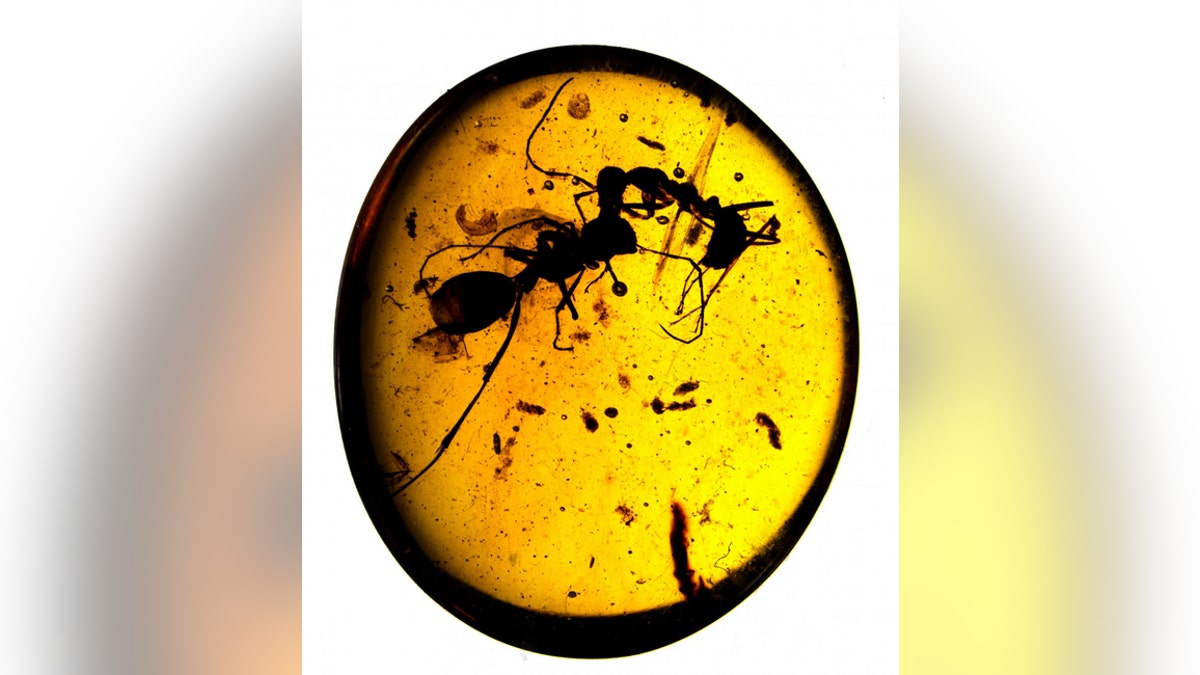
Two 99-million-year-old ant species frozen in eternal battle. (Copyright AMNH/D. Grimaldi and P. Barden)
A weird world of warlike ants and well-armored termites has been found preserved in amber.
The insect fossils, entombed in Burmese amber from Myanmar, date back 99 million years for the ants and 100 million years for the termites. The fossils reveal the startling sociality of these insects very early in their development. The ants cluster together with others of their kind and, in one case, engage in pitched jaw-to-jaw battle. The termites show different body adaptations for soldiers and workers, a hallmark of specialized roles.
"Up until now, the oldest [termite] soldiers that we knew about were 20 million years old, so we have 80 million years longer of a record," said study researcher Philip Barden, a postdoctoral scientist at the American Museum of Natural History (AMNH) in New York. [See Photos of the Battling Ants and Termites Trapped in Amber]
Tough termites
Termites are the oldest known social animal group, Barden told Live Science, and fossil and genetic evidence suggests they emerged in the early Cretaceous period, between 146 million and 100 million years ago. Termite fossils older than 100 million years have been found, he said, but only of winged reproductive termites. The Burmese amber specimens, which are housed in the AMNH collection, are the oldest evidence of castes. Termite colonies today, just like in the Cretaceous, are made up of reproductive individuals with wings, workers responsible for constructing tunnels and collecting food and soldiers responsible for defense.
Workers and soldiers are easy to tell apart, Barden said, because workers are soft and featureless, and soldiers have hard, distinctive heads and strong mandibles. [Gallery: Out-of-This-World Images of Insects]
"A worker is just very killable, and the soldier is like an armored tank of a thing," Barden said.
Reporting online Feb. 11 in the journal Current Biology, the researchers christened one of the newly discovered species found in the amber Gigantotermes rex. The termite was nearly an inch (2 centimeters) long, with thick mandibles. Another new species. Krishnatermes yoddha, got its name from the late termite researcher Kumar Krishna and the Hindi word "Yod'dha," or warrior. All three castes of K. yoddha were found, including a thick-headed soldier, a far more fragile worker and a reproductive termite with diaphanous wings.
It's interesting to find such a clear delineation of roles so early in termite development, because ants — termites' main nemeses — were not yet ecologically dominant 100 million years ago, Barden said.
"It seems that the termite soldier caste isn't necessarily to deal with these early ants," he said. "It was already well-developed when ants were kind of taking their baby steps."
Ancient ants
Those ant baby steps were outlined in a companion paper, also published online in Current Biology. Barden and his colleagues examined Burmese amber fossils of ants from 99 million years ago, only 1 million years younger than the oldest known ant fossils, which were found in France. Ants probably evolved some 50 million years before these fossils, in the late Jurassic or early Cretaceous, but no fossils have been found from that period.
The new fossils reveal that by 99 million years ago, ants were social; though they make up a mere 1 percent of the insect fossils found in the amber, they cluster together far more often than would be expected by chance. For example, the likelihood that one specimen that held 11 Gerontoformica spiralis ants and one Haidomyrmex zigrasi ant would exist by mere happenstance is 1 in 31 quadrillion, the researchers reported. Another piece of amber contains 21 ants of three different species.
One of the most stunning fossils captured workers of two species, G. spiralis and G. tendir, locked in mortal combat with their jaws clasped around each other's appendages. Before either could emerge victorious, amber enveloped the battle, freezing it in place.
The discovery of ant "warfare" is just one line of evidence showing complex social behavior in these insects, Barden said. The researchers also found fossilized workers and queens, revealing that these specializations already existed in ant colonies in the Cretaceous. The discovery was also exciting, Barden said, because the ants are so alien compared with the pests raiding kitchen cabinets today.
Take the Haidomyrmex genus. These now-extinct ants had huge mandibles that may have snapped shut to impale their prey, Barden said. Haidomyrmex (which means "hell ant") survived for at least 20 million years, and its specializations suggest it may have depended on a particular, but unknown, type of prey. Another species, newly described from the Burmese samples, had a camel-like head and bizarre mouthparts covered in pointy hairs.
"It looks almost like 'Predator' from the movies," Barden said.
These long-lost lineages are to today's ants what dinosaurs are to modern birds, Barden said — early adaptions that have now been lost. He and his colleagues are now studying more Burmese fossils as well as the genetics of modern insects to understand how these creatures and their social structures evolved.
"The fossils can be really illuminating for learning about things that are alive today," Barden said. "And the things alive today and the genes within them can be really illuminating for learning about how these early things lived."
- Images: Amazing Dominican Amber Trove
- Image Gallery: Ants of the World
- Mind Control: Gallery of Zombie Ants
Copyright 2016 LiveScience, a Purch company. All rights reserved. This material may not be published, broadcast, rewritten or redistributed.
